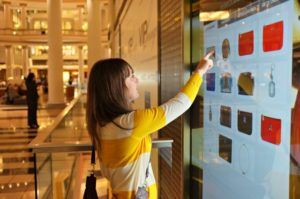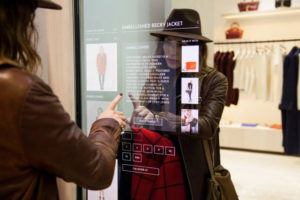Rebecca Minkoff and the Digital Store

Rebecca Minkoff is combining the best of the digital and physical worlds to drive shoppers to her stores.
The rise of online shopping has been crushing traditional retail because of the value it offers to consumers. Over the internet, shoppers can easily compare prices, discover new brands, purchase on the fly, and receive goods quickly for little to no extra cost. Arguably, online retail has not meaningfully increased the size of the pie (people still have the same need for clothing and accessories), but rather made the pie more competitive.
So, how can traditional retailers evolve their model to attract and retain customers at their physical stores? Rebecca Minkoff, a NYC based contemporary fashion retailer, is leading the industry in blending of best of the digital and physical worlds. Rebecca Minkoff’s “connected stores” deliver value to customers through a VIP experience tailored to the customers’ needs and to the company itself through improved data collection and increased revenues.
Rebecca Minkoff’s digital store experience is comprised of 2 main elements: the “connected wall” and the “smart changing room”. Every other element of Minkoff’s stores: clothing racks, stockroom, sales associates etc. are the same as the competitors. A shoppers’ digital experience starts with the “connected wall”, a large mirrored wall with an embedded touch screen computer that allows a shopper to engage with the Rebecca Minkoff brand. Through the wall, shoppers can browse social media content, watch videos of runways shows, order a complimentary beverage, or swipe through pictures of products in the store to begin her shopping experience. By entering in her phone number, the client will receive a text notification when all items she selected to try on have been sent to her dressing room. Operationally, capturing a cell phone number is key for Rebecca Minkoff because the company will facilitate future interactions with the client (inside and outside the store) and collect data on the client via the cell phone number.
The shopper’s digital experience continues upon entering the “smart changing room”. Each changing room is outfitted with RFID technology through which each item brought into the room is “scanned” and listed on the smart mirror (similar in design to the connected wall) inside the changing room. The shopper can use the digital mirror to browse customized styling suggestion, contact a sales associate, or even change the lighting in the dressing room to simulate day or night. Before checking out the shopper can choose to have her activity linked to her personal profile. Shoppers are encouraged to link their activity because it will allow sales associates to reach out to them when new products come in or let them know if a previously sold out size is back in stock.
The sales results of Rebecca Minkoff’s connected stores prove that value is being delivered to the customers. Rebecca Minkoff’s CEO Uri Minkoff noted that, “since opening the store(s)…we’ve made triple the amount of clothing sales than we thought we would.”[1] Customers actively used the interactive mirrors, on average 30% of customers requested an additional item via the fitting room mirror.[2]
The data collected by the RFID technology will also boost Rebecca Minkoff’s sales. Since every item brought into the fitting room is tracked, headquarters is able to see which pieces are tried on but not bought, which pieces are styled together, and which pieces never even make it to the fitting room. This information is invaluable for the merchants as they decide what styles to produce next season. For example, if a particular product was frequently brought into the fitting room but never purchased it can be deduced that there was a fit issue with the product. The team can then study the fit and correct it for the upcoming season.
Is there any downside to this new operating model? Putting the discussion of costs aside, I see two main threats to the model. First, the technology used in the store is not proprietary to Rebecca Minkoff as it was developed through a partnership with eBay’s innovation team. In fact, Healey Cypher, a former member of the eBay innovation team, founded a new firm called Oak Labs, which helped Ralph Lauren put similar technology into its stores.[3] Second, while customers may enjoy novel shopping experiences, they will almost always base a purchasing decision on product alone. If Rebecca Minkoff wants to be a cutting edge digital brand it should work on innovating its product, not just innovating its stores!
(744 words)
[1] “How tech in Rebecca Minkoff’s fitting rooms tripled expected clothing sales”, Digiday.com, 9/23/15
[2] Ibid.
[3] “Inside Ralph Lauren’s connected fitting rooms”, Digiday.com, 4/12/16





Such an interesting digitization within brick and mortar stores! I am curious how this application of digital technology in their store aligns with their broader omnichannel experience. I would hope that they connect this experience to a smartphone app in some way, where then the next time you walk into a store, personalized recommendations would come up – or you would get an email prompting you to order an item online to try.
In a world where retailers are shifting to omnichannel – I fear that this singular move to digitize stores may not be enough.
Thanks for this post, harajukugirl. You lay out really well the innovations that Rebecca Minkoff has worked into its stores and why they may or may not be good additions. One of my main concerns lies with Margaret’s in a similar vein of, adding these digitisation advances to its stores is well and good but does it actually do anything to stem the floodwaters that are flowing to e-commerce? Does it actually solve the issue?
E-commerce is a $220B market in the US alone (http://www.business2community.com/ecommerce/rise-rise-e-commerce-statistics-trends-business-can-capitalize) and whilst the brick and mortar market is $3.9T in the US, the gap between the two is closing quickly. Even with more purchases still being made in stores, two-thirds of in-store shoppers will stick check prices online on their phones before buying. (https://www.nchannel.com/blog/retail-data-ecommerce-statistics/). I worry that whilst the Minkoff in-store additions have grabbed it some good PR and add an element of interest to its stores, the barrier to entry for others to do the same if very low, as you pointed out with Ralph Lauren, and the research and development dollars are not being spent in the right place which is optimising both the product and the experiences for an online world.
This is fascinating! It also sounds like so much fun to try out. I agree with your point about the need to differentiate through products given that other stores can implement the same technology. I do think there is an advantage to being first and establishing a loyal customer base with the data it has accumulated. I think stores can establish brand loyalty not just through their products but through loyalty programs and, especially with clothes, what the brand says about the consumer. Perhaps they can track patterns of what matters most to their target consumers (e.g., sustainability, cost, staying up to date with the latest trends, etc.) and use that information to get ahead.
This also reminds me of the augmented reality apps that are working on making the shopping experience a lot more convenient: http://www.forbes.com/sites/currentaccounts/2016/01/28/virtual-reality-coming-soon-to-a-clothing-store-near-you/#453b681c10ed
Once this hits mainstream, I imagine that stores will need not only product differentiation but also hire expertise on how to curate the content of what is shown in these apps about how the consumer will experience the clothes in different settings.
This is fascinating – I had no idea Rebecca Minkoff was doing this! I wonder if this digital store concept will help the brand compete better with its competitors in the brick and mortar space, but not have much of an impact on its online rivals? While the experience definitely sounds interesting, it still requires customers to physically be present in-store, which is the biggest consumption friction point taken away by online shopping websites and applications. As others have commented above, this would probably be even more of an issue if brick and mortar competitors begin introducing similar concepts into their own stores. Additionally, I would imagine this technology is expensive to install and maintain, which presents issues with scaling. I’m certainly eager to see how this all plays out! In the meantime, will be stopping by a Rebecca Minkoff store the next time I’m in New York!
Thanks for the post. I agree with the prior blog response which raises the view that the true purpose for these in-store technological developments is likely to (1) create buzz and PR for the brand, (2) deliver an exceptional in-store experience, and (3) ensure an omni-channel strategy that compliments the brand’s digital strategy. I’m curious how much these innovations cost the store and what the payback period / ROI entails. One last consideration is that while technology is important in-store, retailers must still focus on engaging with the customer and delivering exceptional customer service from its sales people (human to human). I would make sure that in-store technology isn’t used as a crutch, but rather a supplement for sales people to be more helpful and knowledgeable.